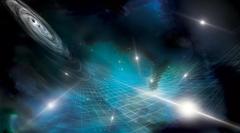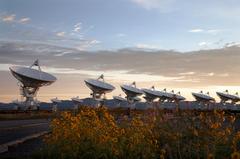The artist's impression shows how a series of pulsars are affected by gravitational waves coming from a pair of supermassive black holes from a distant galaxy. Picture: Aurore Simonnet für die NANOGrav-Kollaboration
Joint Press Release of DESY and University of Münster
For the first time, astrophysicists have found compelling evidence for the existence of gravitational waves which oscillate with periods ranging from years to decades. This is shown in five articles which were published in The Astrophysical Journal Letters on June 29. For this, the researchers evaluated data which the North American Nanohertz Observatory for Gravitational Waves (NANOGrav) had collected over 15 years. Kai Schmitz from the University of Münster and Andrea Mitridate from DESY in Hamburg are involved in one of the research articles. This publication deals with the hypothesis that NANOGrav sees gravitational waves generated in the Big Bang. From Germany, in addition to the team from the University of Münster and DESY, the teams involved in NANOGrav are from the Max Planck Institute for Gravitational Physics in Hannover, and from the University of Mainz.
“This is key evidence for gravitational waves at very low frequencies,” says Vanderbilt University’s Dr. Stephen Taylor, who co-led the search and is the current Chair of the collaboration. “After years of work, NANOGrav is opening an entirely new window on the gravitational-wave universe.”
The NANOGrav Collaboration, which brings together more than 190 researchers, observes pulsars in our Galaxy with large radio telescopes, searching for gravitational waves in the process. A pulsar is the ultra-dense remnant of a massive star's core following its demise in a supernova explosion. Pulsars spin rapidly, sweeping beams of radio waves through space so that they appear to “pulse” when seen from the Earth. “When the pulsar is correctly oriented, this highly regular signal can be measured from the Earth. The effect can be compared with the light cone from a lighthouse which flashes at certain intervals – except that pulsars blink much faster; and in the case of the pulsars observed by NANOGrav, they actually blink in intervals of milliseconds,” explains Kai Schmitz, Associate Professor at the Institute of Theoretical Physics at the University of Münster, who is a member of the NANOGrav Collaboration.
Albert Einstein’s General Theory of Relativity predicts precisely how gravitational waves should affect pulsar signals. By stretching and squeezing the fabric of space, gravitational waves affect the timing of each pulse in a small but predictable way, delaying some while advancing others. Deviations in accordance with a certain pattern attributable to low-frequency gravitational waves are now emerging in the data from 68 pulsars observed – data which the Collaboration collated in 15 years of research work. Earlier results from NANOGrav had actually already uncovered an enigmatic timing signal which was common to all pulsars observed. However, it was too weak for any conclusions to be drawn regarding its origin.
NANOGrav’s most recent dataset shows growing evidence for gravitational waves with periods of years to decades. These waves could arise from orbiting pairs of the most massive black holes in the entire Universe: billions of times more massive than the Sun, with sizes larger than the distance between the Earth and the Sun. From the superposition of the signals from many individual pairs of black holes, there results a diffuse background noise of gravitational waves. Future studies of this signal will open a new window on the gravitational-wave universe, providing insight into titanic black holes merging in the hearts of distant galaxies, among other exotic sources.
The background:
Unlike low-frequency gravitational waves, which can only be detected by means of pulsars, transient high-frequency gravitational waves can be observed using ground-based instruments such as LIGO (Laser Interferometer Gravitational-Wave Observatory). Rainer Weiss, Barry Barish and Kip Thorne were awarded the Nobel Prize for Physics in 2017 for the first direct measurement of high-frequency gravitational waves with the LIGO detector in 2015. The new NANOGrav results now open up a new frequency band in the gravitational waves spectrum – a band which stands in relation to the LIGO frequency band such as long radio waves do to visible light in the electromagnetic spectrum. Moreover, NANOGrav is not tracking down transient gravitational waves, but rather a continuous background noise which reaches the Earth continuously and from all directions.
The publication of the NANOGrav results has been coordinated with research teams working on gravitational waves all over the world; each of these teams are also presenting their new results on June 29. Besides NANOGrav, these are further so-called pulsar timing array collaborations from Australia, China, Europe and India which together are organized in the International Pulsar Timing Array (IPTA).
Paper by Kai Schmitz and his team (University of Münster) and Andrea Mitridate (DESY) on the June 29 publications
The signal seen by NANOGrav might also receive a cosmological contribution in the form of gravitational waves from the early universe. This hypothesis is examined in detail in one of the five published studies headed by Kai Schmitz and Andrea Mitridate, a postdoc at DESY in Hamburg. “In our work,” Andrea Mitridate elaborates, “we take a close look at the possibility that NANOGrav is seeing gravitational waves generated fractions of a second after the Big Bang – instead of a signal of astrophysical origin emitted by titanic black holes orbiting each other at the centers of galaxies.” Such a primordial background of gravitational waves should be seen as a gravitational counterpart to the cosmic microwave background – the “afterglow” of the Big Bang discovered in the 1960s.
“Many theories relating to new physics beyond the Standard Model of particle physics predict the generation of gravitational waves in the Big Bang – including phenomena such as cosmic inflation, cosmological phase transitions or so-called cosmic strings,” Kai Schmitz explains. Andrea Mitridate adds that, “In this sense, the NANOGrav data enable us to examine models of new physics at energies which are unachievable in laboratory experiments on Earth.” Further studies will be needed, however, to determine which argument will ultimately win through: the astrophysical interpretation in the form of binary systems of supermassive black holes, or the cosmological interpretation in the form of gravitational waves from the Big Bang.
Funding for the research
The NANOGrav collaboration receives support from National Science Foundation Physics Frontiers Center award numbers 1430284 and 2020265, the Gordon and Betty Moore Foundation, NSF AccelNet award number 2114721, a Natural Sciences and Engineering Research Council of Canada (NSERC) Discovery Grant, and the Canadian Institute for Advanced Research (CIFAR). The Arecibo Observatory is a facility of the National Science Foundation operated under cooperative agreement (#AST-1744119) by the University of Central Florida (UCF) in alliance with Universidad Ana G. Méndez (UAGM) and Yang Enterprises (YEI), Inc. The Green Bank Observatory and The National Radio Astronomy Observatory are facilities of the National Science Foundation operated under cooperative agreements by Associated Universities, Inc.
Original publication with participation of the working groups of the University of Münster and DESY
Adeela Afzal et al./ The NANOGrav Collaboration (2023): The NANOGrav 15-year Data Set: Search for Signals from New Physics. The Astrophysical Journal Letters, DOI: 10.3847/2041-8213/acdc91









